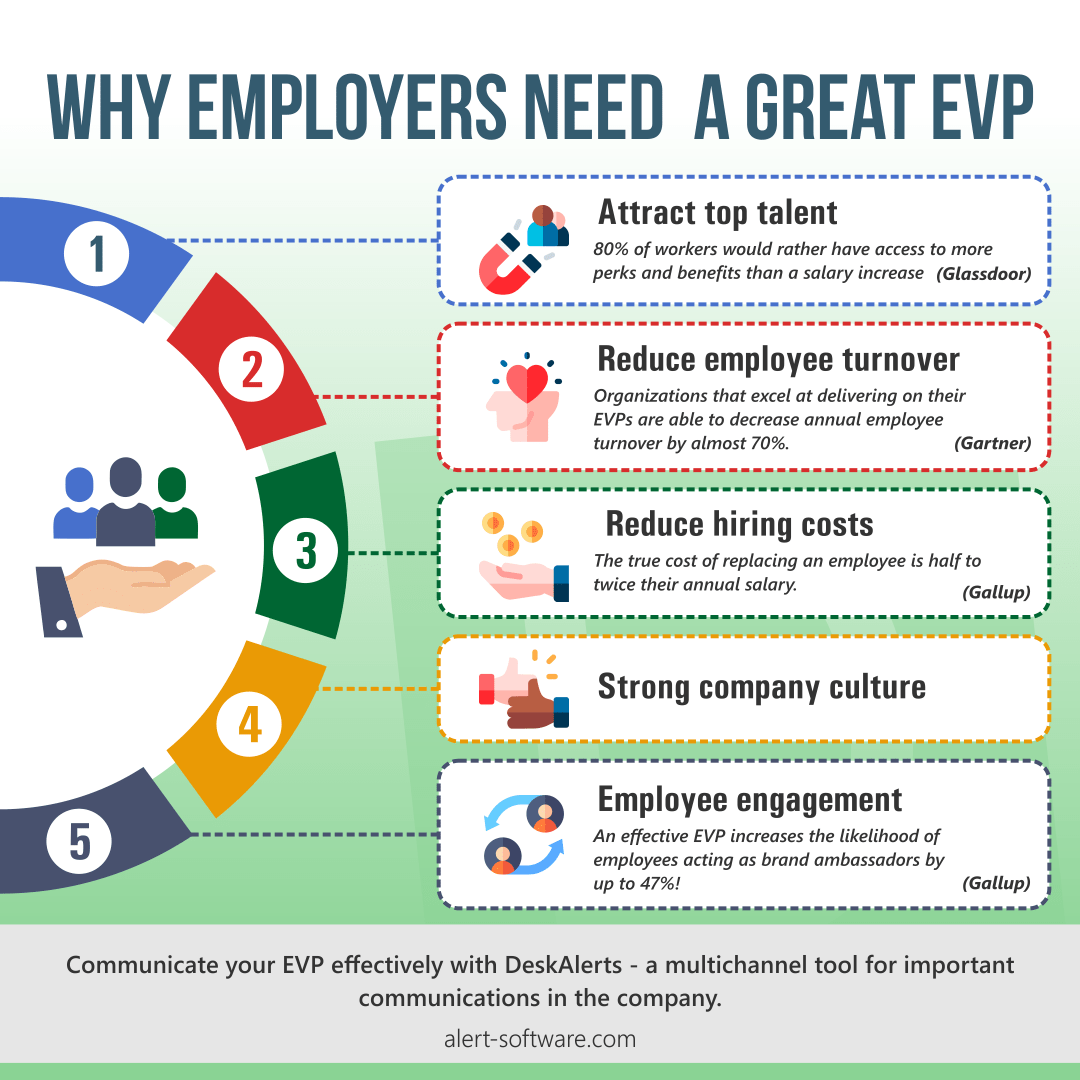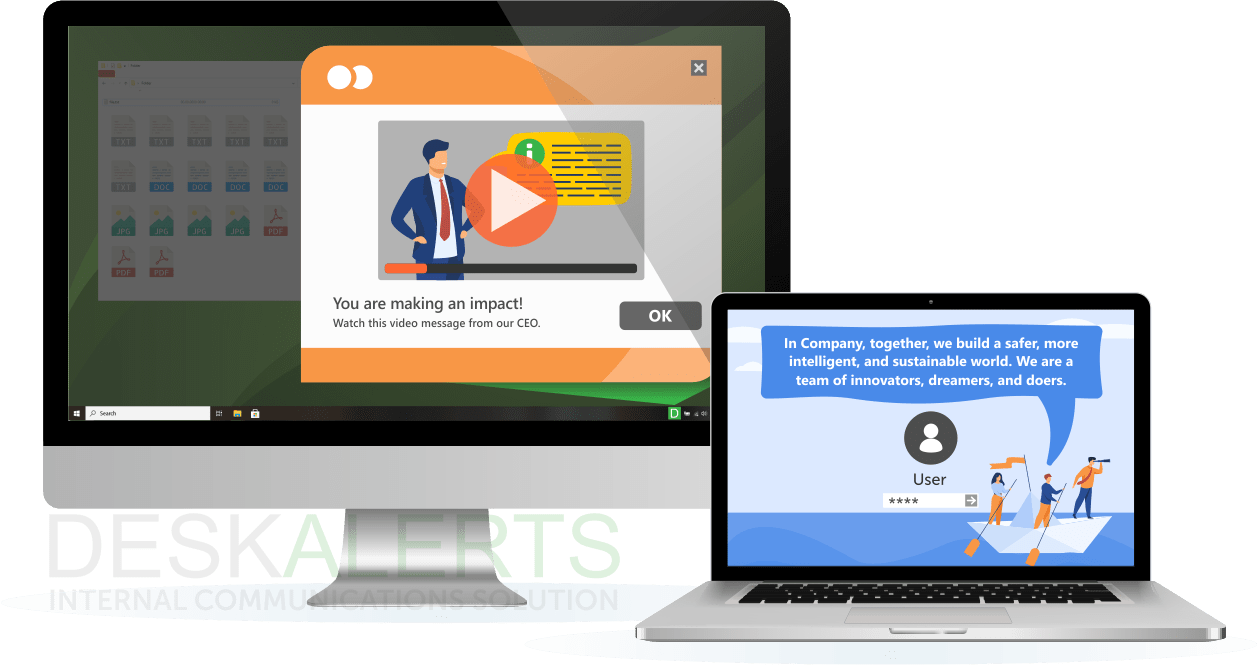
Attracting and retaining the top talent in your industry gives your company an advantage over your competition. Defining and understanding your organization’s unique employee value proposition (EVP) will help you to capitalize on your strength in the recruitment space.
Table of contents
What is an employee value proposition (EVP)?
Why employers need a great EVP
Why an EVP is more important than ever in 2021
7 steps to create an EVP in your organization
Real-life Employment Value Proposition examples
How to promote and communicate your EVP within your organization
What is an employee value proposition (EVP)?
So what is an EVP anyway? An employee value proposition is a definition of what makes your corporate culture unique. It synthesizes the reasons employees give as being positive benefits working for the organization and the promises the organization makes to employees about what they will provide in exchange for the skills and capabilities they bring to the organization.
Companies use the EVP to create their employer brand when putting themselves forward as potential employers. Internally, it is used to reinforce to employees what makes the company great and why they should continue to be part of its success story.
The bottom line is, people don’t want to work for an organization that provides a poor working environment and horrible workplace culture.
According to a survey by CareerArc, 75% of job seekers will consider a company’s reputation as an employer before even applying for a job there.
Why employers need a great EVP
An EVP helps companies to tackle several issues that can be complicated and difficult to navigate.
1. Attracting top talent
It can be difficult to find the right person to do the job, especially if you are in an industry that is affected by skills shortages. Salary alone isn’t always enough to attract people to want to work for your company – and not every company is in a position to be able to offer large pay increases. An attractive EVP, however, helps your company to appeal to potential new recruits.
A Glassdoor survey found that 80% of workers would rather have access to more perks and benefits than a relatively small salary increase.
These are the things a job candidate will thoroughly examine before deciding to work for your organization.
2. Reducing employee turnover
Happy employees generally don’t look for a new job. If you have a great EVP not only can you attract great talent, but you can keep it too. This means that you won’t lose your best assets to your competition, and you can retain corporate knowledge.
According to Gartner research, the organizations that excel at delivering on their EVPs are able to decrease annual employee turnover by almost 70%.
3. Reduces hiring costs
With reduced employee turnover comes reduced costs associated with hiring new employees.
Gallup research places a conservative estimate of the true cost of replacing an employee as being half to twice their annual salary.
In an organization with high turnover, this can quickly become millions of dollars each year.
4. Helps to establish a strong company culture
Your EVP serves as a reminder to both your employees and the outside world what your organizational culture is like, what makes it a great place to work and why you’re an employer of choice.
5. Helps drive employee engagement
Engaged employees are dedicated to their employer and are willing to go above and beyond to ensure that the company succeeds. When employees feel aligned to a company’s values, they are more likely not only to be engaged, but they’ll want to tell people about it.
According to research by Link Humans, an effective EVP increases the likelihood of employees acting as brand ambassadors by up to 47%!
Read more: Employee engagement ROI

Why an EVP is more important than ever in 2021
The world of work has undergone a massive shake-up this year, and many organizations are struggling to replace staff who are resigning in droves.
The COVID-19 pandemic got the ball rolling, changing the way that people work. Many employees who had been craving flexibility for years but had been told they weren’t able to work from home or change their work hours were suddenly able to do so without productivity suffering. Many of these people, when confronted with employers demanding they return to the office, are reluctant to go back to the way things were before and are seeking opportunities with genuine work/life balance.
But what employees want varies. Other workers became burned out and disillusioned during the pandemic, particularly those “essential employees” on the front line working with hostile members of the public in unsafe or risky conditions.
And for some other people, the pandemic has prompted them to re-evaluate what is important in life. They may have had a brush with COVID and survived, or lost friends and family members, and are reconsidering how they want to spend their time on Earth.
All of this has led to a phenomenon known as “the Great Resignation” with millions of people this year walking away from their jobs, often causing chaos in their wake for the employers they are leaving behind. Many businesses made it through lockdowns and restrictions only to be unable to reopen fully because they’ve lost their staff and can’t find replacements.
Of course, it’s not that people don’t want to work at all: many still do. They would just rather prefer to work somewhere with a strong workplace culture and benefits and opportunities that suit their lives, and the employee value proposition can offer meaning.
Learn what employees want and how they feel about their work with this free HR survey bandle
- COVID-19 Employee Survey (33 questions)
- Workplace Stress Assessment Questionnaire (19 questions)
- Top 25 Internal Communications Questions (25 question)
- 41 Questions For Your Anonymous Survey (41 questions)
- 30 Employee Satisfaction Survey Questions (30 questions)

What are the components of an EVP?
Every business and every industry is different, so the specifics of an employment value proposition for your company may not be great for another company. It is important that your EVP is an honest portrayal of life as an employee in your company. Companies that dupe candidates into thinking they are a great place to work on paper and then don’t deliver will be found out, thanks to social media and employer rating websites like Glassdoor, and will have an even harder time than before in being able to attract talent.
In general, however, these are the components that go into building your EVP:
1. Salary and other compensation
While salary isn’t always the most important factor for every employee, it’s still important, especially if they could make a lot of money elsewhere doing the same thing. It’s important, therefore, that you provide a competitive salary and ensure that any other cash components, such as bonuses, are attractive.
2. Attractive benefits
What one employee values as a benefit may be of little to no value to another. For this reason your company should offer flexible benefits to employees that reflect their differences in both personal preference and stages of life.
There are numerous benefits that employers can provide their staff, including:
- health care
- various insurance options
- retirement assistance
- subsidised childcare,
- subsidised gym memberships
- subsidised public transport tickets
- paid leave,
- education opportunities
- paid professional memberships
- subscriptions
3. Rewards and recognition programs for employee valuation
There are different ways to run these, but essentially, they are programs that help employees feel valued and appreciated for their contributions to the company’s success. Rewards are different from cash bonuses that form part of an employee’s remuneration package: they are a gesture of appreciation. They might include vouchers, access to discounts, gifts, extra paid time off, or holiday accommodation.
4. Opportunities for career progression
Many potential recruits aren’t just looking for their next job. They’re looking at the jobs they’ll have after that and want to build a clear path to achieving their career goals. Companies that offer training and development opportunities are attractive to these potential recruits. This can include undertaking further study, participating in training courses, mentorship, and job shadowing opportunities.
5. The workplace environment
What sort of workplace do you have to offer people? In terms of company culture, people are attracted to a friendly, collaborative workplace where people are respected and bullying, harassment and toxic gossip aren’t tolerated.
In addition to this, people want to work in a physically safe workplace. And they want to have the right tools, equipment and support to do their jobs successfully.
7 steps to create an EVP in your organization
An EVP doesn’t have to be a complex piece of work, but there are some steps you can take to make the process as pain-free as possible.
1. Determine your goals
While every company may have similar reasons to develop an EVP, some will have specific goals that they want to achieve in doing so. It might be that staff turnover has been too high and this needs to be addressed. Or perhaps you’re having problems recruiting at all and have lots of vacancies.
By identifying why your company needs an EVP you can tailor one effectively.
2. Involve your current employees
One of the best resources you have at your disposal when developing an EVP is your current employee cohort. Survey them and ask what they value about working at your company and ask them what they would like to improve. There’s no point guessing at it.
3. Draft your EVP
Your EVP doesn’t need to be a lengthy document: it should be clear and to the point, synthesizing what your current employees value as well as any additional workplace changes that you are going to offer. It should also reflect your company’s mission, vision and goals. Your EVP should be realistic and not promise things that you cannot or won’t be able to deliver.
4. Align your current practices with the EVP
Look at your current practices and policies and determine if they align with your EVP. For example, if you promise flexibility for new recruits and your HR policies don’t allow it, this will only lead to an unfavorable and disappointing experience.
5. Communicate your EVP
You need to tell your current employees about your EVP, and this should be an ongoing dialogue reminding them of what it is and what it means. You also need to communicate it to potential recruits so it should also be visible on your external-facing communication channels.
6. Embed your EVP in your corporate culture
There should be a commitment from management from the top down to actually live and breathe the values you espouse in your EVP and not merely pay lip service to them. You need to deliver what you promise.
7. Assess your EVP for success
Measurement is important for any initiative like this. When you started the EVP process, you set a goal or goals. Did you achieve them? You won’t know unless you incorporate metrics into the process. Qualitative and quantitative measurements can help you to establish this. For example, you can see if there has been an improvement in turnover. Surveying employees can give you insights into how things are going.
Real-life Employment Value Proposition examples
Your EVP statement will distill the most significant aspects of what your company has to offer as a pitch to new recruits. Essentially you need to tell potential candidates what it is your organization offers its employees in exchange for their effort and time.
Some examples of real-life EVPs include:
Stripe (an online payments processing platform)
“At Stripe, we're looking for people with passion, grit, and integrity. You're encouraged to apply even if your experience doesn't precisely match the job description. Your skills and passion will stand out—and set you apart—especially if your career has taken some extraordinary twists and turns. At Stripe, we welcome diverse perspectives and people who think rigorously and aren't afraid to challenge assumptions.”
Hershey (a confectionary manufacturer)
“Haven’t reached your full potential yet? Neither have we. There’s more to be made”
The Hershey employee value proposition is great because asks an engaging question:
“ARE YOU SOMEONE WHO WANTS TO HELP US WRITE THE FUTURE STORY OF HERSHEY’S?”
Strava (internet exercise tracking service)
“You will engage in interesting and challenging work that will improve the lives of our athletes. And in the same way that Strava is deeply committed to unlocking the potential of our athletes, we are dedicated to providing a world-class workplace where our employees can grow and thrive.”
Canva (graphic design app)
“Sometimes the chance comes up to be part of something really special. Canva is making design amazingly simple for everyone, and the potential is limitless. We’re empowering people to design anything and publish anywhere.”
Nike (sportswear brand)
“We lead. We invent. We deliver. We use the power of sport to move the world.”
How to promote and communicate your EVP within your organization

Promoting your EVP internally is just as important as promoting it externally to new recruits. Communicating your EVP with your employees will help to reinforce the EVP and your commitment to making it a reality.
- Create appropriate internal branding for your EVP
Establishing a visual “look and feel” as well as consistent key messages that you reinforce when you communicate your EVP will help to establish it with employees and give it credibility.
- Conduct internal marketing campaigns
Market your EVP to employees deploying the same types of marketing strategies you would use internally. You want their buy-in and you want them to understand it.
- Find ways to incorporate it in all of your internal messaging
Even when you are communicating other things to employees, there are ways you can link most things that you do to your EVP and you will be able to find hooks to incorporate EVP messaging.
- Use a range of internal communications channels
Sending similar messages via a range of different channels is a good way to ensure that people are exposed to your communications campaign. Repetition also helps to reinforce what you are trying to communicate. Try an internal communications software solution like DeskAlerts.
You can develop visual communications collateral such as screensavers or digital displays as well as send text-based information like pop-up alerts, scrolling tickers or emails.
DeskAlerts keeps your employees informed, no matter where they are, by delivering messages to different devices, including mobile phones and digital signage.
Messages are delivered in a couple of seconds. You can send messages to all employees or just specific targeted segments of your employee cohort.
Employees are also able to subscribe to information they want to know about. And DeskAlerts engagement statistics will help you to create better content.
DeskAlerts is also an effective tool to gather the information that can inform your EVP via its survey module – surveys are sent to employees in a way that they can’t ignore and you will quickly see the results in real time.
Learn more about DeskAlerts.
***
Developing an EVP will help you to sell your organization to both potential employees and continue to sell it to the employees you already have so they can be convinced to continue working for your company. In this ever-changing world of instability in recruitment, it might make the difference between recruiting top talent and not being able to fill critical positions in your company.
FAQs
What makes up the EVP?
There are several key elements that contribute to making an Employee Value Proposition (EVP). These attributes, when combined, will contribute to how your organization is perceived as an employer by both existing employees and job candidates. These elements include remuneration, lifestyle factors, security and stability, workplace culture, benefits and respect.
What makes a great EVP?
A great EVP is one that is designed around attributes that will be guaranteed to attract the top talent in your industry, and will also keep them engaged and retain them once recruited. It should also align with your company’s overall strategic goals. It should also be truthful. In fact, most of it should already exist. You are just telling people about it in a new way. Of course, you can commit to improvements, but you have to deliver on these as well.
How can I improve my EVP?
There are several proven ways to improve your company’s Employee Value Proposition. These include:
- Ensuring that you publicly acknowledge any outstanding achievements by your employees and providing appropriate rewards for this conduct.
- Taking the time to thank your employees in person for the work that they have done.
- Providing opportunities for growth and for employees to further develop their skill sets.
- Having your senior leadership team role model the values.
Why do you need an EVP?
An EVP is important to your recruitment processes as it is the foundation of your employer brand. By presenting new recruits with a pitch about what is attractive about working for your organization, you are offering more than just a salary. This will help you find the top talent in your field and assist with employee retention. The EVP can set you apart from other companies in your industry.
For existing employees, it can help to increase engagement.
 Caroline Duncan
Caroline Duncan










